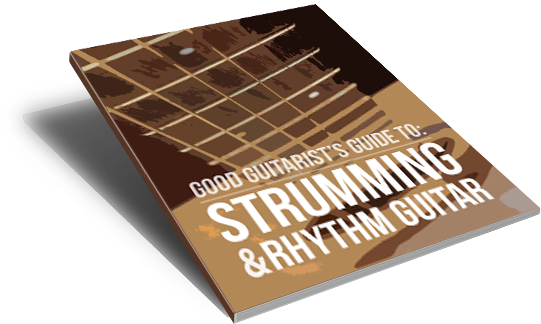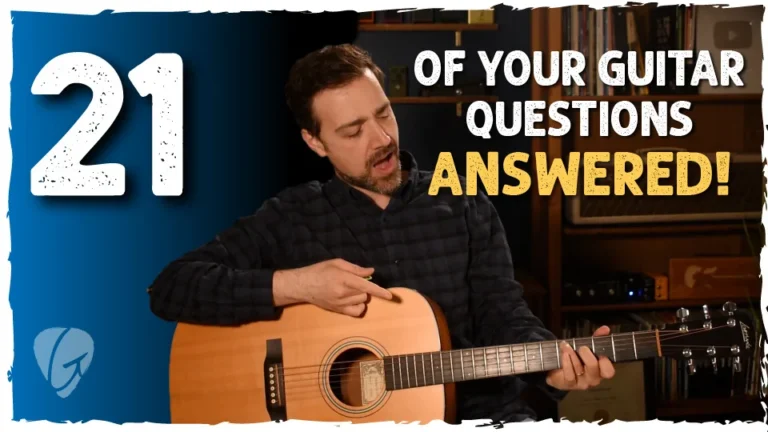Learn Music Theory on Guitar with Real Song Examples
Learn essential music theory through “Me and Bobby McGee”! Discover key changes, chord progressions, and how to choose the easiest key for your voice – all on guitar.
Hey, it’s James here from GoodGuitarist.com and in this lesson, I want to show you one of the most important pieces of music theory for guitar – using Me and Bobby McGee as our example.
This song is a perfect case study because it’s simple on the surface, but has a key change that teaches us a lot about how music works.
Why This Song Is Perfect for Understanding Music Theory
Me and Bobby McGee starts out as a plain ol’ three-chord song in the key of A – just A, D, and E. Then, halfway through, it suddenly jumps up to the key of B with B, E, and F#.
Even if you don’t know a thing about music theory, you feel that change. It’s uplifting and energizing. And that’s what a key change can do when used right.
This shift teaches one of the most fundamental concepts in theory – whole steps and key changes – in a way that just makes sense.
How to Hear and Understand the Key Change
The first part of the song stays in one key, and then partway through, it jumps up a whole step. It sounds almost the same, but subtly brighter and more energetic. That’s the power of moving up a whole step – from A to B in this case.
It happens right after the first chorus. Give it a listen on your favorite music service (or bust out that ol’ vinyl if you have one!)
The Trick: The Never-Ending Line of Notes
To really see this, I use what I call the Never-Ending Line of Notes:
A . B C . D . E F . G . A . B C . D . E F . G . A . B C . D . E F . G .
The letters are the natural notes, and the dots are the sharp and flat notes.
There is no dot between B & C – that means there’s no B sharp, or C flat. Likewise for E and F.
This visual helps us understand distances between notes – a whole step means skipping over a note, and a half step means going to the note right beside.
Key takeaway: If you’re in the key of A and want to move up a whole step, you land on B.
How to Use This in the Real World
Here’s the breakdown of the chords in the original key:
Key of A:
- A (1)
- D (4)
- E (5)
Key of B:
- B (1)
- E (4)
- F# (5)
So the structure is a classic 1-4-5 progression, used in countless songs. That’s where the Nashville Number System comes in – we replace chords with their scale degrees and then swap them for the new key.
How to Pick an Easier Key to Play It In
What if you’re not a fan of barre chords?
Let’s find a version that’s beginner-friendly by checking a few common keys:
| Key | Chords (1-4-5) | Easy? |
|---|---|---|
| C | C – F – G | F is tough, maybe |
| A | A – D – E | ✅ Yes |
| G | G – C – D | ✅ Yes |
| E | E – A – B | B is tough ❌ |
| D | D – G – A | ✅ Yes |
✅ Winner: Key of G
It uses only open chords, and when you modulate up to A (a whole step), you’re still using simple shapes.
That’s actually what Janis Joplin’s version does!
Applying This Theory to Any Song
This is the kind of real-world music theory that actually helps you play better.
Once you understand how to:
- Recognize key changes
- Use the number system
- Shift songs into easier keys
…you’ll have way more flexibility. Whether you’re singing, playing solo, or just trying to make things easier on your fingers, this is the kind of knowledge that makes a difference.
Want More Help?
🎸 Ready to get serious about guitar?
Join my Premium Membership – it’s your all-access pass to all my courses, bonuses, and a private community to help you learn the right way.
Whether you’re just starting or leveling up, I’ll guide you step-by-step to make real progress.
Now go play some Bobby McGee – and enjoy that beautiful key change!
Have a fun time practicing!
-James
All-Access Pass
Start your 10-day FREE trial
- Step-By-Step Courses
- Exclusive YouTube Bonuses
- Q&A with James






